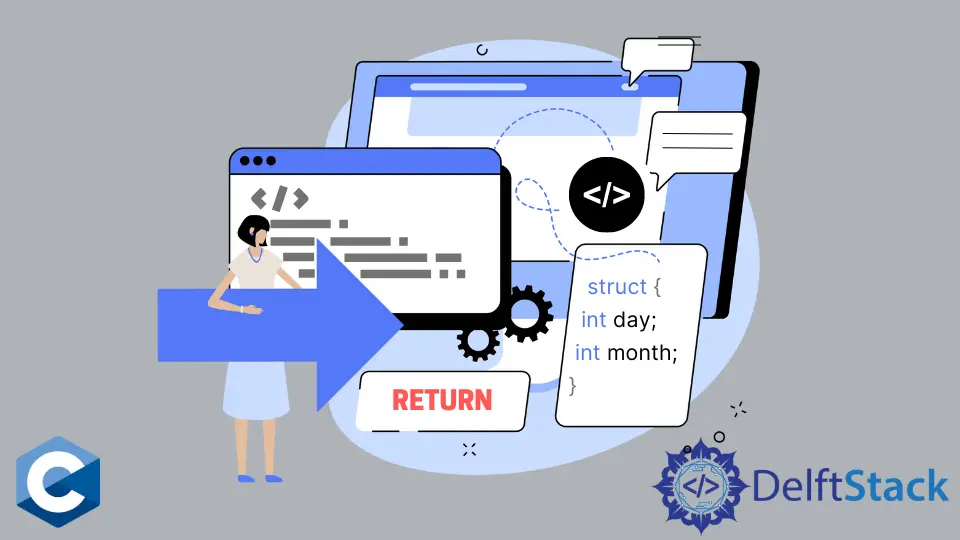在 C 语言中从函数中返回结构体

本文将演示关于如何在 C 语言中从函数中返回结构体的多种方法。
使用标准符号从函数中返回结构体
C 语言中的 struct 关键字是用来实现用户定义的数据结构体。由于我们在这个例子中定义了 struct 类型,所以如果我们我们对 MyStruct 结构体进行 typedef 定义,那么对于函数声明来说将是一个更简洁的符号。它将为给定的结构关联一个新的类型别名,我们只需要在函数原型中指定新的别名即可。现在,C 语言中的函数可以返回类似于内置数据类型的 struct。
在下面的示例代码中,我们实现了一个 clearMyStruct 函数,该函数接收一个指向 MyStruct 对象的指针,并按值返回相同的对象。需要注意的是,当句柄是指向 struct 的指针时,我们需要使用 -> 运算符访问 struct 成员。
#include <stdio.h>
#include <stdlib.h>
enum { DAY = 9, MONTH = 2 };
typedef struct {
int day;
int month;
} MyStruct;
MyStruct clearMyStruct(MyStruct *st) {
st->day = 0;
st->month = 0;
return *st;
}
int setMyStruct(MyStruct *st, int d, int m) {
if (!st) return -1;
st->day = d;
st->month = m;
return 0;
}
int main() {
MyStruct tmp;
if (setMyStruct(&tmp, DAY, MONTH) == -1) exit(EXIT_FAILURE);
printf("day: %d\nmonth: %d\n", tmp.day, tmp.month);
clearMyStruct(&tmp);
printf("day: %d\nmonth: %d\n", tmp.day, tmp.month);
exit(EXIT_SUCCESS);
}
输出:
day: 9
month: 2
day: 0
month: 0
使用指针符号从函数中返回结构体
一般来说,struct 定义的数据结构往往包含多个数据成员,导致内存占用很大。现在,在函数之间传递比较大的结构时,最好使用指针。指针作为对象的一个句柄,无论那里存储的是什么结构,它的大小都是固定的。使用指针来返回 struct,有可能减少内存流量,使代码的性能更高。虽然程序在编译时有优化标志,但它可能会隐性地修改数据传递指令。注意,我们利用 enum 类型来声明命名的常量整数值。
#include <stdio.h>
#include <stdlib.h>
enum { DAY = 9, MONTH = 2 };
typedef struct {
int day;
int month;
} MyStruct;
MyStruct *clearMyStruct2(MyStruct *st) {
st->day = 0;
st->month = 0;
return st;
}
int setMyStruct(MyStruct *st, int d, int m) {
if (!st) return -1;
st->day = d;
st->month = m;
return 0;
}
int main() {
MyStruct tmp;
if (setMyStruct(&tmp, DAY, MONTH) == -1) exit(EXIT_FAILURE);
printf("day: %d\nmonth: %d\n", tmp.day, tmp.month);
clearMyStruct2(&tmp);
printf("day: %d\nmonth: %d\n", tmp.day, tmp.month);
exit(EXIT_SUCCESS);
}
输出:
day: 9
month: 2
day: 0
month: 0
Founder of DelftStack.com. Jinku has worked in the robotics and automotive industries for over 8 years. He sharpened his coding skills when he needed to do the automatic testing, data collection from remote servers and report creation from the endurance test. He is from an electrical/electronics engineering background but has expanded his interest to embedded electronics, embedded programming and front-/back-end programming.
LinkedIn